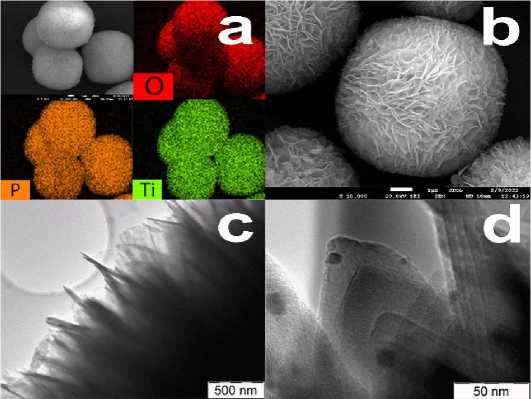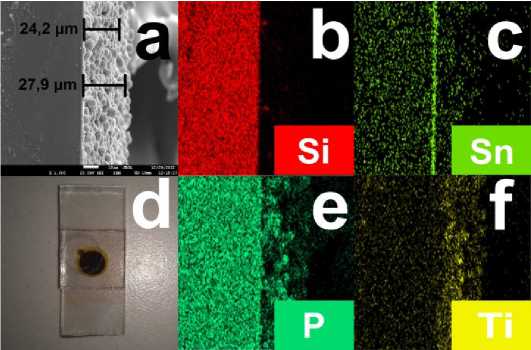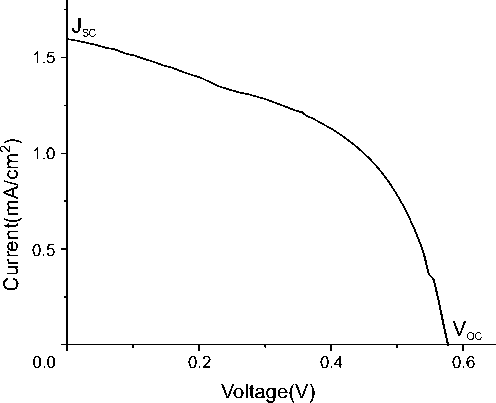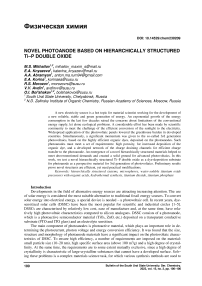Novel photoanode based on hierarchically structured Ti-P double oxide
Автор: Mikhailov M.S., Knyazeva E.A., Abramyan A.A., Korina E.A., Morozov R.S., Avdin V.V., Bolshakov O.I.
Журнал: Вестник Южно-Уральского государственного университета. Серия: Химия @vestnik-susu-chemistry
Рубрика: Физическая химия
Статья в выпуске: 2 т.15, 2023 года.
Бесплатный доступ
The study of trialkylborane as a component of the initiating system with oxygen was carried out using the example of graft polymerization of alkyl(meth)acrylate vinyl butyl ether copolymer units on pectin polysaccharide. The amine complex triethylborane-hexamethylenediamine was introduced into a boiling mixture of an aqueous solution of pectin in vinyl butyl ether, after which a solution of the active monomer, alkyl(meth)acrylate, containing methacrylic acid, was introduced by the compensation method to isolate triethylborane from the complex. As a result of synthesis from a mixture containing butyl acrylate, three immiscible parts were formed: organic, aqueous, and between them a “sponge” that did not dissolve in any of the phases. In the case of methyl methacrylate, only two parts were formed in the mixture: organic and aqueous. Water-soluble and organic polymers were dried under vacuum conditions to constant weight at T = 20-25 °C. Gravimetric analysis showed that the “sponge” was a mixture of water-soluble and organic polymers at 50:50 ratio. To do this, the dried polymers were dissolved alternately in water and vinyl butyl ether. Graft copolymers pectin-methyl methacrylate-vinyl butyl ether and pectin-butyl acrylate-vinyl butyl ether were isolated from the aqueous phase of the synthesized systems, in relation to the introduced acrylate. In comparison with the original pectin, the molecular weight of the water-soluble fraction increased significantly. Comparison of the IR spectrum of the graft copolymer pectin-methyl methacrylate-vinyl butyl ether with the IR spectra of pectin and the IR spectrum of pectin-methyl methacrylate indicated that all the bands characteristic of pectin, polymethyl methacrylate, and polyvinyl butyl ether were observed for the new polymer sample. Freeze-dried samples of pectin and pectin-methyl methacrylate-vinyl butyl ether graft copolymer were examined using scanning electron microscopy. A comparative analysis showed a change in the structure of pectin fibers as a result of its copolymerization with a copolymer of methyl methacrylate-vinyl butyl ether. The obtained data confirm the addition of synthetic polymers alkyl (meth) acrylate-vinyl butyl ether to the basis of the pectin macromolecule. New substances are polymer molecules containing natural and synthetic fragments with an ordered structure. Such compounds are promising as the basis for wound healing coatings.
Pectin, butyl acrylate, methyl methacrylate, vinyl butyl ether, triethylborane, molecular weight parameters, graft copolymers
Короткий адрес: https://sciup.org/147240920
IDR: 147240920 | УДК: 54.03 | DOI: 10.14529/chem230209
Текст научной статьи Novel photoanode based on hierarchically structured Ti-P double oxide
Developments in the field of alternative energy sources are attracting increasing attention. The use of solar energy is considered the most suitable alternative to traditional fossil energy sources. To convert solar energy into electrical energy, a special device is needed – a photovoltaic cell. In recent years, dye-sensitized solar cells (DSSC) have been the most popular for scientific and industrial circles [1–5]. DSSCs are characterized by relatively low cost, ease of manufacture and, at the same time, have relatively high photovoltaic characteristics compared to silicon analogues. DSSC consists of a photoanode, which is a photoactive semiconductor material (TiO2, ZnO, etc.) deposited on a transparent conductive substrate (FTO and ITO glass) and an electrolyte sensitizer.
The main component of photoanodes is photoactive material, which plays an important role in determining the photocurrent, photon voltage and energy conversion efficiency. It was found that the size, structure and morphology of photoanode materials have a significant impact on the photovoltaic characteristics of DSSC. To ensure high efficiency, a number of requirements are imposed on the material: small particle size (10–20 nm), high specific surface area (above 100 m2/g) and a high degree of crystallinity. At the same time, the requirements are to some extent mutually exclusive, since a high degree of crystallinity is characteristic of large-crystalline substances that cannot have a developed surface. Solving these problems is a complex materials science task, for which various synthesis methods are used to obtain various structures, including hierarchically structured systems. Hierarchically structured materials are attractive because their architecture combines the features of micro- and nanoscale materials and have unique properties that differ from those of the corresponding monomorphological structures.
The main semiconductor materials for photoanodes having a hierarchical structure are nanoscale TiO 2 and ZnO, obtained by various methods [1–11]. These materials are characterized by high crystallinity, particle size of 20–100 nm and a developed surface of more than 60 m2/g, providing an efficiency of 3–5 %. There are a number of disadvantages associated with nanoscale materials: nanoparticles weakly scatter light, and too small internal pores prevent the penetration of the electrolyte. Therefore, one of the solutions to these problems is to obtain microstructured systems assembled from nanotubes, nanoplates and etc. [4, 5, 12–15]. Such an approach will provide the material with a developed surface, a large particle size that is comparable to the wavelength of visible light, can increase the efficiency of light collection due to the effective scattering effect. In addition, dense packing, especially in the case of spherical structures, forms a good transport path for electrons.
One of the most promising materials are titanium and zirconium phosphates. In our article, it is proposed to use hierarchically microstructured titanium phosphate as a photoactive material. This material was obtained by hydrothermal treatment of titanium complex with mandelic acid in the presence of phosphoric acid. The resulting material has the form of microflowers and is described by SEM, XRD, etc.
Experimental
Reagents
DL-Mandelic acid (100 %, Bingospa), NH4OH (25 %, NevaReaktiv), H2O2 (40 %, Biokhim-Reagent), titanium powder PTM–1, H 3 PO 4 (98 %, Vekton) were used without preliminary purification.
General methodology for obtaining WSTP
In accordance with the previously published method [16]: 0.41 g (8.5 mmol) of titanium, 40 ml of 40 % H 2 O 2 solution and 5 ml of NH 4 OH solution are placed in a 100 ml Erlenmeyer flask. The reaction mixture is stirred on a magnetic stirrer until titanium is completely dissolved (from 1 to 1.5 hours), maintaining the temperature of the mixture in the range of 5 to 10 °C. After dissolution, a light yellow solution of titanium peroxocomplex is filtered and an organic acid (17 mmol) solution in 2–3 ml of water is added to it. After adding an acid, the temperature of the reaction mixture is kept between 15–20 C for another 2–3 hours. Isolation of titanium complexes with hydroxoacids from aqueous solutions is carried out by evaporation at a reduced pressure in a rotovap at 30–40 °C.
Obtaining microstructured TPDO via hydrothermal method
A dry water-soluble complex of titanium with an organic acid was placed in a Teflon cup for an autoclave in the amount of 1,66 mmol for the mandelic acid complex – 0.69 g per 20 ml. The dry complex was dissolved in 5 ml of water, after which phosphoric acid (PA) was added to the complex. Then, the total volume was adjusted to 20 ml by adding water. The prepared aqueous solutions was sealed in a Teflon-coated stainless steel autoclave and heated at 180 °C for 24 hours. After cooling the autoclave, the solids were separated from the solutions by washing and centrifugation. The precipitates were dried in an oven at a temperature of 50 °C.
Characterization
The registration of IR transmission spectra was carried out on a Shimadzu IRAffinity S1 IR-Fourier spectrometer in the range from 400 to 4000 cm–1 with a resolution of 4 cm–1 and in the number of 40 repetitions. Elemental analysis and morphology of the samples were studied using a Jeol JSM 7001F electron microscope equipped with an Oxford INCA X-max 80 energy dispersive spectrometer. Accelerating voltage of electron gun was set to 20 kV required for quantitative EDS analysis. The TEM microphotographs of TPDO were recorded with a transmission electron microscope JEOL JEM-2100 with a working voltage of 200 kV. The phase composition and structure of the samples were studied on a Ri-gaku Optima IV powder diffractometer. The survey was carried out in the range of 2θ angles from 5° to 90° at a survey rate of 5°/min. The study used radiation from a CuK α copper tube (λ = 1.541 Å) at an accelerating voltage of 40 kV. Specific surface area and porosity were measured with by low-temperature nitrogen adsorption on an ASAP Micromeritics 2020 instrument. The measurement stage was preceded by a degassing carried out at a temperature of 200 C for 2 hours. The specific surface area was determined based on the BET multilayer adsorption method. The volume of mesopores and their size distribution was calculated based on the Barrett–Joyner–Halenda (BJH) model.
General procedure for fabrication and characterization of DSSCs
The photoanodes were prepared from FTO glass (3 mm thick, 8 Ω sheet resistance, Solaronix), which was successively cleaned in “Elma tec clean A1” solution (aq., 2 g/L), deionized water, acetone, 99.8 w % ethanol under sonication for 15 minutes each. The glasses were placed in an ultrasonic-ozone radiation source for 30 minutes. Immersion of the glass in an aqueous TiCl4 solution (40 mM) at 80 °C for 30 minutes followed by rinsing with deionized water and ethanol was carried out to deposit a blocking layer on the FTO sample. The layer of TiO 2 formed was sintered at 500 °C for 30 minutes in a furnace.
Highly concentrated suspension of Ti-P double oxide in terpenol were screen printed onto the FTO in one layer (mesh count 70, thread diameter 6.0 mm, area 0.283 cm2), with 10 minutes heating on a hotplate at 120 °C after that. The photoanodes were sintered in a programmable furnace at set temperatures of 325, 375, 450, and 500 °C for 5, 5, 15, and 15 minutes with a ramping time of 10 minutes. Then the electrodes were immersed in an aqueous TiCl 4 solution (40 mM) at 80 °C for 30 minutes, and after rinsing with deionized water and ethanol were annealed at 500 °C for 30 minutes in a furnace.
The counter electrodes were prepared from FTO glass (3 mm thick, 8 Ω sheet resistance, Sola-ronix). Holes were drilled into the electrodes from the FTO-side using a diamond drill bit; this procedure was carried out under water. The glass plates were then cleaned using “Elma tec clean A1” (aq., 2 g/L), deionized water, and 99.8 w % ethanol in an ultrasonic bath for 15 minutes each. The electrodes were platinized using Platisol T/SP (Solaronix, Swiss) by doctor-blading and sintered at 500 °C for 30 minutes in a furnace.
The photoanodes were heated again to 80–100 °C and immersed into a toluene solution of WS-2 (3 mM) overnight. The solar cells were assembled by sandwiching the two electrodes together using a sealant (Meltonix 1170-25), and heated to 120 °C, applying even pressure to ensure the Meltonix melted evenly. Electrolyte was vacuum filled into the hole and the hole was sealed by Meltonix and a cover glass. The electrolyte used was butylmethylimidazolium iodide (0.60 M), I2 (0.05 M), lithium iodide (0.05 M), guanidinium thiocyanate (0.1 M), and t -butylpyridine (0.50 M) dissolved in acetonitrile.
The J-V characteristics of DSSCs were measured with a Keithley 2400 unit under a Sciencetech Sci-Sun150 solar simulator with an AM 1.5 G filter, calibrated to 100 mW/cm2 with a Sciencetech Calibrated Reference Cell SCI-REF-Q.
Results and Discussion
A hierarchically structured titanium-phosphorus double oxide was obtained by hydrothermal means from a complex of titanium with almond acid in the presence of phosphoric acid. SEM-micrographs of the obtained sample are microstructures with the morphology of “microflowers”. They have high uniformity, low proportion of impurities, insignificant aggregation of particles. SEM micrographs and the elemental distribution of microspheres on EDS indicate that the constituent elements: Ti, P and O are evenly distributed over the entire surface of the microspheres. The spherical structure of the titanium and phosphorus double oxide is complex and has a micro-dimensional flower-like hierarchy based on nanoplates. The observed pattern is in good agreement with the hierarchical structures of titanium phosphates previously described in the literature, where hemispheres consist of flakes [17, 18]. A distinctive feature of our material is that the spheres have a fine dispersion and are not agglomerated.
Transmission electron microscopy studies confirm the complex nature of microspheres consisting of plates and scales (Fig. 1), which is also consistent with the TEM images described earlier in the literature [17, 18]. We could not see the lattice bands in the scales and assumed that they were mostly amorphous. Particle size analysis was performed using micrographs measuring at least 100 microspheres in each sample to obtain an average size and dispersion. The average particle size is 5.1 ±0.8 µm. At the same time, the specific surface area of the double oxide is 50.3 m2/g.
Thus obtained microspherical material.
DSSCs performance
To determine the applicability of the received the hierarchically structrured Ti–P double oxide microspheres as photoanode for DSSCs, test cells with a well-known dye WS-2 [19], chosen as a reference dye, an iodine electrolyte, and a Pt film as the counter electrode were constructed. The WS-2 dye was chosen as the reference dye due to its high extinction coefficient, broad absorption spectrum, and syn- thetic availability. For a stable and uniform TiO2 layer on the surface of a conductive FTO-glass the procedure for applying a concentrated suspension of the hierarchically structrured Ti-P double oxide microspheres was used in terpenol using a doctor-blade method to obtain one layer of photoanode with a thickness 24–29 μm (Fig. 2).

Fig. 1. Morphology and EDS of TiP-1:12 Morphology and EDS of titanium-phosphorus double oxide (a, b); TEM micrographs of titanium-phosphorus double oxide (c, d)

Fig. 2. View of the microsphere-based photovoltaic cell (a);
SEN microphotograph with the microspheres deposited on the FTO-glass (b, c, e, f); Elemental mapping of the photoanode on the edge (d)
The photocurrent density-voltage ( J - V ) curves were recorded under standard AM 1.5G illumination conditions (100 mW cm–2). The J-V curve, obtained for the most high-performance cell based on the hierarchically structrured Ti-P double oxide microspheres, is shown in Fig. 3, and the parameters obtained are summarized in Table 1. Although a voltage of the open circuit ( V oc ) value lies at the near the standard values of the conventional DSSC [20,21] the low numbers of the short circuit current density ( J s c ) determine the low power conversion efficiency (η). We hypothesize that poor contact of the constituting flakes making up the microspheres as a major obstacle in the conducting the current to the photoanode. And thus a more intimate contact of the constituent structural elements with FTO is required for a better efficiency of the DSSC.
Table 1
DSSC characteristics for the best cells based on the hierarchically structured Ti-P double oxide microspheres
|
V oc (V) |
J sc (mA cm–2) |
FF (%) |
η (%) |
|
0.577 |
1.73 |
45 |
0.27 |

Fig. 3. J-V curve of the DSSC based on the hierarchically structured Ti-P double oxide microspheres
Conclusions
Here we report a first assembly of the photoanode with the novel hierarchically structured light absorbing layer based on Ti-P double oxide microspherical particles. Although a significant specific surface area and well defined hierarchical structure of the Ti-P microspheres are an excellent prerequisite for utilization as a photoanode material, low power conversion efficiency obtained show that a more intimate contact is required between spheres and FTO-glass for a utilization in DSSC. We will continue working on a further improvement of the hierarchically structured photoanodes for efficient light absorbing substartes.
Acknowledgment
This work was financially supported by the Russian Foundation for Basic Research (Grant № 2003-00904).
Список литературы Novel photoanode based on hierarchically structured Ti-P double oxide
- Zhu K. et al. Enhanced charge-collection efficiencies and light scattering in dye-sensitized solar cells using oriented TiO2 nanotubes arrays. Nano Lett. 2007;7(1):69-74. DOI: 10.1021/nl062000o.
- Mor G.K. et al. Use of highly-ordered TiO 2 nanotube arrays in dye-sensitized solar cells. Nano Lett. 2006;6(2):215-218. DOI: 10.1021/nl052099j.
- Paulose M. et al. Backside illuminated dye-sensitized solar cells based on titania nanotube array electrodes. Nanotechnology. 2006;17(5):1446-1448. DOI: 10.1088/0957-4484/17/5/046.
- Suh D.I. et al. The fabrication and characterization of dye-sensitized solar cells with a branched structure of ZnO nanowires. Chem. Phys. Lett. 2007;442(4-6):348-353. DOI: 10.1016/ j.cplett.2007.05.093.
- Zhu Y.F. et al. Synthesis of highly-ordered hierarchical ZnO nanostructures and their application in dye-sensitized solar cells. Cryst. Res. Technol. 2010;45(10):1075-1078. DOI: 10.1002/crat.201000325.
- Xu C. et al. Preferential growth of long ZnO nanowire array and its application in dye-sensitized solar cells. J. Phys. Chem. C. 2010;114(1):125-129. DOI: 10.1021/jp9085415.
- Kim D. et al. Bamboo-type TiO2 nanotubes: Improved conversion efficiency in dye-sensitized solar cells. J. Am. Chem. Soc. 2008;130(49):16454-16455. DOI: 10.1021/ja805201v.
- Adachi M. et al. Highly efficient dye-sensitized solar cells with a titania thin-film electrode composed of a network structure of single-crystal-like TiO2 nanowires made by the "oriented attachment" mechanism. J. Am. Chem. Soc. 2004;126(45):14943-14949. DOI: 10.1021/ja048068s.
- Greene L.E. et al. ZnO - TiO2 core-shell nanorod/P3HT solar cells. J. Phys. Chem. C. 2007; 111(50): 18451-18456. DOI: 10.1021/jp077593l.
- Plank N.O.V. et al. Efficient ZnO nanowire solid-state dye-sensitized solar cells using organic dyes and core-shell nanostructures. J. Phys. Chem. C. 2009; 113(43):18515-18522. DOI: 10.1021/jp904919r.
- Taratula O. et al. Binding studies of molecular linkers to ZnO and MgZnO nanotip films. J. Phys. Chem. B. 2006;110(13):6506-6515. DOI: 10.1021/jp0570317.
- Liao J.Y. et al. Tri-functional hierarchical TiO 2 spheres consisting of anatase nanorods and nanoparticles for high efficiency dye-sensitized solar cells. Energy Environ. Sci. 2011;4(10):4079-4085. DOI: 10.1039/c1ee01574e.
- Liao J.Y. et al. Effect of TiO2 morphology on photovoltaic performance of dye-sensitized solar cells: Nanoparticles, nanofibers, hierarchical spheres and ellipsoid spheres. J. Mater. Chem. 2012;22(16):7910-7918. DOI: 10.1039/c2jm16148f.
- Cheng H.M. et al. Formation of branched ZnO nanowires from solvothermal method and dye-sensitized solar cells applications. J. Phys. Chem. C. 2008;112(42):16359-16364. DOI: 10.1021/jp805239k.
- Chen W., Yang S. Dye-sensitized solar cells based on ZnO nanotetrapods. Frontiers of Optoelectronics in China. 2011;4(1):24-44. DOI: 10.1007/s12200-011-0207-0.
- Heintz N.S. et al. Sorption of Titanium Complexes with Organic Acids on Titanium (IV) Oxide. Bulletin of the South Ural State University. Ser. Chemistry. 2021;13(2):79-88. DOI: 10.14529/chem21020.
- Yada M. et al. Synthesis and controllable wettability of micro-and nanostructured titanium phosphate thin films formed on titanium plates. ACS Appl. Mater. Interfaces. 2014;6(10):7695-7704. DOI: 10.1021/am500974v.
- Wang X. et al. Novel flower-like titanium phosphate microstructures and their application in lead ion removal from drinking water. J. Mater. Chem. A. 2014;2(19):6718-6722. DOI: 10.1039/c4ta00246f.
- Wu Y. et al. Hexylthiophene-featured D-A-n-a structural indoline chromophores for coadsor-bent-free and panchromatic dye-sensitized solar cells. Adv. Energy Mater. 2012;2(1): 149—156. DOI: 10.1002/aenm.201100341
- Mikhailov M.S. et al. 9-(p-Tolyl)-2,3,4,4a,9,9a-hexahydro-1H-carbazole - A new donor building-block in the design of sensitizers for dye-sensitized solar cells. J. Photochem. Photobiol. A Chem. 2020;391:112333. DOI: 10.1016/j.jphotochem.2019.112333.
- Tanaka E. et al. Structural features of indoline donors in D-A-n-A type organic sensitizers for dye-sensitized solar cells. Mol. Syst. Des. Eng. 2021;6(9):730-738. DOI: 10.1039/d1me00054c.


